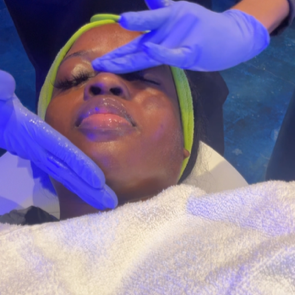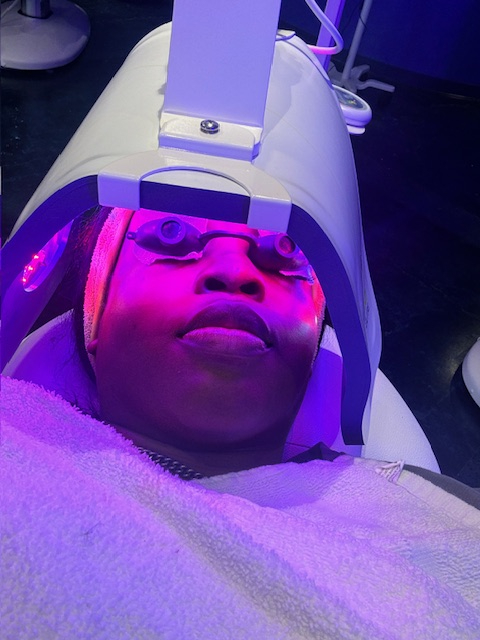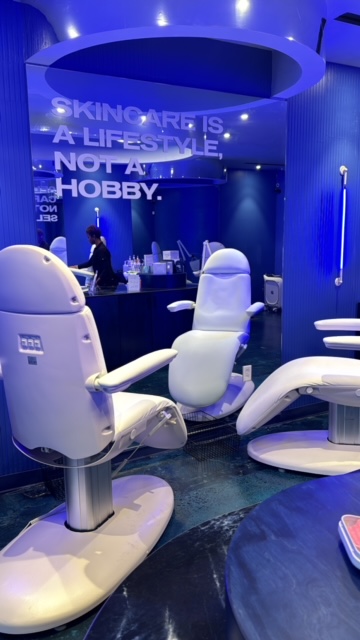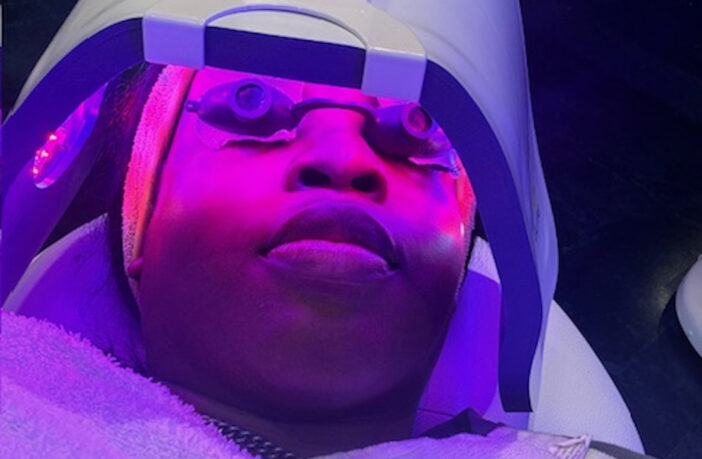Red light therapy promises a lot. It heals, rejuvenates and washes away your sins. Okay, so there is no technical proof for that last thing, but hearing devout light therapy users wax poetically about its benefits makes it seem like red light therapy can give you glass skin and sing the gospel at the same time.
 Image: courtesy of Tayler Adigun.
Image: courtesy of Tayler Adigun.
Online, red light therapy is one of the buzziest skin care terms to enter the wellness lexicon in a while.
There are red light wands, red light blankets and cyborg-like red light masks, all glowing with the ruby-hued promise of rejuvenated skin. The concept has even permeated the fitness world, with red light Pilates studios and infrared saunas popping up all over the country.
On TikTok, there are thousands upon thousands of videos related to red light therapy, and both full-time influencers and medical professionals alike have touted the good word of red light therapy.
Someone come get me & all my wellness antics! 

 #biohacking #wellness #sauna #lighttherapy #routine #relatable #redlightsauna #hubermanlab #hubermanhusband @Cameron & Elijah @Andrew Huberman
#biohacking #wellness #sauna #lighttherapy #routine #relatable #redlightsauna #hubermanlab #hubermanhusband @Cameron & Elijah @Andrew Huberman
♬ Lil Boo Thang – Paul Russell
So clearly, everyone wants a piece of that red light pie, but what is it really all about?
To learn more about red light therapy and what it can do for the skin, I took a trip over to Hi, Skin, a curiously exquisite spa with an industry-disrupting aura. Think less sterile white textiles and more Gen Z-tinged cool, á la subversive graphics, ultra-modern design profiles and space-ship-esque interiors. It’s not just a regular facial bar; it’s a cool facial bar!
So, if you’re curious about red light therapy or just find yourself to be a general skincare voyeur, read on.
 Image: courtesy of Tayler Adigun.
Image: courtesy of Tayler Adigun.
What is Red Light Therapy?
Red light therapy uses photobiomodulation, aka low-level laser therapy, to deliver red and near-infrared light to various areas of your body. It works by penetrating deep into the skin, where the mitochondria absorb the light particles, causing your skin to produce more energy sources.
So, how does all of this science jargon translate into glowing skin? “Red light therapy stimulates collagen production, reduces inflammation, accelerates wound healing, and improves circulation,” Hallie Font, Hi, Skin’s VP of Esthetics & Product Development told EBONY.
Various studies have proven red light therapy to be an efficacious hair growth aid, and studies also show promising results related to skin roughness and the appearance of wrinkles. According to the Cleveland Clinic, red light therapy can also spur cell-destroying reactions that can treat skin conditions like psoriasis, acne, and warts.
So, unlike some of the more gimmick skin care trends surging through the ether, red light therapy has science on its side. And that’s pretty good company.
Is it Safe for Deeper Skin Tones?
Call me paranoid, but I am quite the skeptic when it comes to putting anything too techy near my face, especially as a dark-skinned woman.
So when I heard the word laser mentioned concerning this practice, my guard went up. I mean, there are far too many examples of melanated skin being damaged by trendy spa treatments. The beauty industry, by and large, has a major issue accounting for the needs of darker skin tones.
Thankfully, though, red light therapy is a low-level laser comprised of a range of both red and near-infrared light, so deeper skin complexions need not fret. Not only is it safe for darker skin tones, but red light therapy can aid in reducing hyperpigmentation.
 Image: courtesy of Tayler Adigun.
Image: courtesy of Tayler Adigun.
When Should We be Using Light Therapy?
So now that we know it’s safe for darker skin tones, how do we incorporate it into our routine? At Hi, Skin, all of their services are finished with both red and blue light therapy.
Now, red light might be dominating the skin care milieu right now, but blue light is another effective light therapy practice, just with a cerulean twist. “Blue light therapy targets acne-causing bacteria, regulates oil production, and reduces inflammation, making it effective for treating acne and preventing future breakouts,” said Font.
My facial was tailored to my unique skin care concerns. (Dry skin and hyperpigmentation, hive rise!) and included a thorough cleanse, enzyme treatment and extractions.
Now, to be clear, these aren’t your regular at-home extractions, and hasty pimple-popping sessions are still frowned upon. This is because when you pop your pimples at home, you run the very real risk of spreading the bacteria from one inflamed zone to other areas of your face, causing an even bigger breakout than what you initially had. And who wants that?
Conversely, professional extractions utilize sterile equipment that keeps the skin safe while effectively removing excess oil and pore-clogging debris that can lead to bigger breakouts. There are also a host of boosters that can be added to your facials, including dermaplaning, brightening, hydrating and clearing infusions. I also received a dermaplaning treatment, which is a literal godsend for people who struggle with dry skin like myself. Bonus: dermaplaning also allows for deeper penetration of your skincare products.
Still, ever the skeptic, I was curious to understand how professional dermaplaning differed from taking an Amazon-grade eyebrow razor to your face. But as my facialist and licensed esthetician, Frances Spencer, explained, there is a big difference between the big boy tools licensed professionals use vs the value pack offerings we can get during Prime Day.
 Image: courtesy of Tayler Adigun.
Image: courtesy of Tayler Adigun.
“When you’re using dermaplane scalpels, they’re a lot sharper, so they’re able to not only remove the hair, but remove that top layer of skin as well. And when you’re using that eyebrow razor, it’s not sharp enough, so it’s creating micro-tears, and the hair is only just kind of getting cut down,” explained Frances.
To wrap up my treatment, I was placed under a red light and then a blue light. Immediately after my facial, my skin felt softer and smoother, which is always a plus, but long-term results will be seen after regular treatments. “Clients should generally receive a facial every four weeks, as this aligns with the skin’s natural regeneration cycle,” said Font.
However, the frequency may vary based on your unique skincare concerns and those with specific issues like acne may benefit from more frequent treatments, around every two to three weeks. Now, there are also several at-home red light masks on the market, but studies about their effectiveness vary. The optimal wavelength for red light therapy is between 630 and 700 nanometers, which is important to keep in mind when looking for any at-home red light masks.
But whether you’re a DIY savant or fancy yourself as something of a maintenance maven, red light therapy is a worthy addition to your beauty cache.



